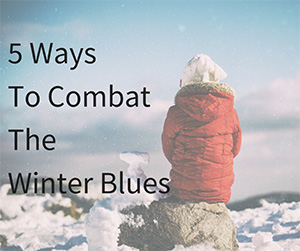5 Tips to Combat the Winter Blues
 Many of our BPAR clients, friends, families and colleagues are battling what we call the “Winter Blues.” The Winter Blues are characterized by less energy, more fatigue despite sleeping, feeling down or “blue,” having trouble getting up in the mornings, and gaining weight/craving carbohydrates. The Winter Blues are symptoms often associated with Seasonal Affective Disorder (see below).
Many of our BPAR clients, friends, families and colleagues are battling what we call the “Winter Blues.” The Winter Blues are characterized by less energy, more fatigue despite sleeping, feeling down or “blue,” having trouble getting up in the mornings, and gaining weight/craving carbohydrates. The Winter Blues are symptoms often associated with Seasonal Affective Disorder (see below).
The good news is there are things you can do to fight those blues and be proactive. Many of the below tips are useful to start before the gloomy winter months. Some studies find January and February to be the hardest months in terms of winter blues or Seasonal Affective Disorder (SAD).
Not sure if you are experiencing Winter Blues or Seasonal Affective Disorder (SAD)?
Seasonal Affective Disorder has been linked to the change in seasons when we experience less sunlight and shorter days. This causes a shift to our internal biological clocks. SAD impacts about 5% of the population and is more common in women then men.
SAD is different than the winter blues. Many individuals with SAD experience all of the above symptoms of fatigue, sadness, weight gain/increased food cravings, and/or social withdrawal, but to a much greater degree. Individuals affected by SAD may sleep as much as four more hours a day, and/or experience greatly increased appetite. It can mimic depression and interfere with functioning in daily life. Their symptoms usually disappear in the spring and summer. Women can even report worsening of premenstrual symptoms!
If you are not sure if you are experiencing SAD, check with your doctor or nurse practitioner.
Here are 5 Tips to Combat Winter Blues:
1). Happy Light: Happy Lights increase your serotonin and can help regulate circadian clocks. They can be so effective that doctors sometimes recommend light therapy for SAD BEFORE anti-depressants! Try using a Happy Light for 15-20 minutes a day. It should be placed at face level, 11-24 inches away, and angled a little away from your face. Consistency is important – try it daily and monitor your mood. See this website for contraindications and talk to your doctor before trying light therapy.
2). Consider supplements of Vitamin D or Omega 3: Vitamin D helps our brain make serotonin and boosts our mood. Research has found that the fatty acids in Omega 3 also have a positive impact on mood and mood regulation.
3). Exercise: Get out whenever you can! Exercise mimics antidepressants and boosts mood and confidence. If it’s too cold, try a new gym class or yoga at home in front of your Happy Light. Check out this free YouTube station: FightMaster Yoga.
4.) Socialization: A symptom of SAD is withdrawal. You may experience this as a “hibernating” feeling – not wanting to leave the house, or only wanting to eat and drink more. Watch this closely and buddy up – make a pact with a friend to leave the house, volunteer or socialize in a warm place. Make it a priority to see a friend, schedule a show or movie or a make a healthy dinner together. Be careful not to turn to alcohol or recreational drugs for relief.
5). Sleep hygiene. Get enough sleep to feel rested, and maintain regular times of bedtimes and waking. Avoid sleeping too much, as SAD symptoms and winter blues can often lead people to feel like hibernating.
We have many BPAR clients who report success with battling the winter blues using a combination of regular psychotherapy, seeing their doctor or nurse practitioner, AND trying several of the above tips for self-care! See what works for you and focus on being proactive and consistent!
Still looking for more ideas? Check out this How to Combat the Winter Blues blog post written by Kelly DiBenedetto during one of the most challenging winters in recent Massachusetts history!
Written by KC Craig, LICSW
Boston Post Adoption Resources